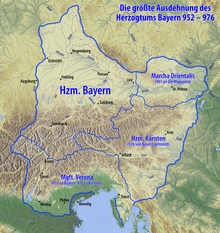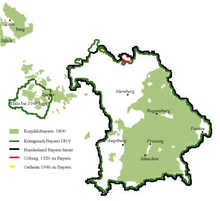Bavaria,[a] officially the Free State of Bavaria,[b] is a state in the southeast of Germany. With an area of 70,550.19 km2 (27,239.58 sq mi), it is the largest German state by land area, comprising roughly a fifth of the total land area of Germany, and with over 13.08 million inhabitants, it is the second most populous German state, behind only North Rhine-Westphalia; however, due to its large land area, its population density is below the German average. Major cities include Munich (its capital and largest city, which is also the third largest city in Germany),[5] Nuremberg, and Augsburg.
The history of Bavaria includes its earliest settlement by Iron Age Celtic tribes, followed by the conquests of the Roman Empire in the 1st century BC, when the territory was incorporated into the provinces of Raetia and Noricum. It became the Duchy of Bavaria (a stem duchy) in the 6th century AD following the collapse of the Western Roman Empire. It was later incorporated into the Holy Roman Empire, became the independent Kingdom of Bavaria after 1806, joined the Prussian-led German Empire in 1871 while retaining its title of kingdom, and finally became a state of the Federal Republic of Germany in 1949.[6]
Bavaria has a distinct culture, largely because of its Catholic heritage and conservative traditions,[7] which includes a language, cuisine, architecture, festivals and elements of Alpine symbolism.[8] It also has the second-largest economy among the German states by GDP figures, giving it the status of a wealthy German region.[9]
Contemporary Bavaria also includes parts of the historical regions of Franconia and Swabia, in addition to Altbayern.
Though Bavaria has been occupied by humans since the Paleolithic era, Celtic tribes of the Bronze Age, such as the Boii were the first documented inhabitants of the Bavarian Alps. In June 2023, Archeologists discovered a bronze sword, dated to the 14th century BC, in a former Celtic village; its workmanship so well-preserved "it almost shines."[10] During the early modern era, these peoples were retrospectively romanticized as the most ancient culture of Bavaria,[11] even though the Indo-European languages were relative newcomers to the region. Evidence of the ancient Straubing culture, Únětice culture and La Tène culture may be found in what is Bavaria today.[12][13][14]
Archeologists know of a large Celtic Iron Age settlement which was founded in Feldmoching-Hasenbergl, in the North of suburban Munich.[14] Evidence suggests up to 500 people lived in the village from 450 BC.[14] Local life appears to have centred around what could be a town hall or temple, and continued in different forms up to 1000 AD.[14] In Manching, Upper Bavaria, an unfortified and semi-urban society appears to have prospered between the 3rd century BC until the early 1st Century AD.[15] The settlement featured food ovens, pottery kilns and metallurgical furnaces.[15] By 200 BC the community there was active in trade—finds of coins, along with an icon-like golden tree suggest it was trading with distant Italo-Greek communities.[15]
In the 1st Century BC, Bavaria was conquered by the Roman Empire.[16] An imperial military camp was built 60 km north-west of where Munich sits today, under orders of Augustus Caesar, between 8 and 5 BC.[17] The camp later became the town of Augusta Vindelicorum, which would become the capital of the Roman province of Raetia.[17] Another fort was founded in 60 AD, west of modern-day Manching, as evidenced by a legionnaire's sandal found near remains of an ancient fort.[18] By the late 2nd Century AD, Germanic tribes, including Marcomanni people, were pushing back on Roman forces of Marcus Aurelius and later, Commodus in the Marcomannic Wars.[19] By 180 AD, Commodus had decided to abandon the annexed positions in Bavaria, leaving its control to Celtic and Germanic tribes.[20]
Around the year 500AD, some elements of that victorious Marcomanni people would helpform the Bavarii confederation, which incorporated Bohemia and Bavaria.[21] In the 530s, the Merovingian dynasty incorporated the kingdom of Thuringia after their defeat by the Franks. The Baiuvarii were Frankicised a century later.[22] The Lex Thuringorum documents an upper class nobility of adalingi.[23] From about 554 to 788, the house of Agilolfing ruled the Duchy of Bavaria, ending with Tassilo III who was deposed by Charlemagne.[24]
Tassilo I of Bavaria tried unsuccessfully to hold the eastern frontier against the expansion of Slavic peoples and the Pannonian Avars around 600. Garibald II seems to have achieved a balance of power between 610 and 616.[25]
At Hugbert's death in 735, the duchy passed to Odilo of Bavaria from the neighboring Alemannia. Odilo issued a Lex Baiuvariorum for Bavaria, completed the process of church organization in partnership with Saint Boniface in 739, and tried to intervene in Frankish succession disputes by fighting for the claims of the Carolingian dynasty. He was defeated near Augsburg in 743 but continued to rule until his death in 748.[26][27]
Saint Boniface completed the people's conversion to Christianity in the early 8th century. Tassilo III of Bavaria succeeded to rule Bavaria. He initially ruled under Frankish oversight but began to function independently from 763 onward. He was particularly noted for founding new monasteries and for expanding eastwards, oppressing Slavs in the eastern Alps and along the Danube and colonizing these lands. After 781, however, Charlemagne began to exert pressure and Tassilo III was deposed in 788. Dissenters attempted a coup against Charlemagne at Regensburg in 792, led by Pepin the Hunchback.

With the revolt of Henry II, Duke of Bavaria in 976, Bavaria lost large territories in the south and southeast.
One of the most important dukes of Bavaria was Henry the Lion of the house of Welf, founder of Munich, and de facto the second most powerful man in the empire as the ruler of two duchies. When in 1180, Henry the Lion was deposed as Duke of Saxony and Bavaria by his cousin, Frederick I, Holy Roman Emperor (a.k.a. "Barbarossa" for his red beard), Bavaria was awarded as fief to the Wittelsbach family, counts palatinate of Schyren ("Scheyern" in modern German). They ruled for 738 years, from 1180 to 1918. In 1180, however, Styria was also separated from Bavaria. The Electorate of the Palatinate by Rhine (Kurpfalz in German) was also acquired by the House of Wittelsbach in 1214, which they would subsequently hold for six centuries.[28]
The first of several divisions of the duchy of Bavaria occurred in 1255. With the extinction of the Hohenstaufen in 1268, Swabian territories were acquired by the Wittelsbach dukes. Emperor Louis the Bavarian acquired Brandenburg, Tyrol, Holland and Hainaut for his House but released the Upper Palatinate for the Palatinate branch of the Wittelsbach in 1329. That time also Salzburg finally became independent from the Duchy of Bavaria.
In the 14th and 15th centuries, upper and lower Bavaria were repeatedly subdivided. Four Duchies existed after the division of 1392: Bavaria-Straubing, Bavaria-Landshut, Bavaria-Ingolstadt and Bavaria-Munich. In 1506 with the Landshut War of Succession, the other parts of Bavaria were reunited, and Munich became the sole capital. The country became a center of the Jesuit-inspired Counter-Reformation.
In 1623, the Bavarian duke replaced his relative of the Palatinate branch, the Electorate of the Palatinate in the early days of the Thirty Years' War and acquired the powerful prince-elector dignity in the Holy Roman Empire, determining its Emperor thence forward, as well as special legal status under the empire's laws. During the early and mid-18th century the ambitions of the Bavarian prince electors led to several wars with Austria as well as occupations by Austria (War of the Spanish Succession, War of the Austrian Succession with the election of a Wittelsbach emperor instead of a Habsburg).[29]
To mark the unification of Bavaria and the Electoral Palatinate, both being principal Wittelsbach territories, Elector Maximilian IV Joseph was crowned king of Bavaria. King Maximilian Joseph was quick to change the coat of arms. The various heraldic symbols were replaced and a classical Wittelsbach pattern introduced. The white and blue lozenges symbolized the unity of the territories within the Bavarian kingdom.[30]
The new state also comprised the Duchy of Jülich and Berg as these on their part were in personal union with the Palatinate.[citation needed]

When the Holy Roman Empire dissolved under Napoleon's onslaught, Bavaria became a kingdom in 1806 and joined the Confederation of the Rhine.[31]
The Duchy of Jülich was ceded to France and the Electoral Palatinate was divided between France a